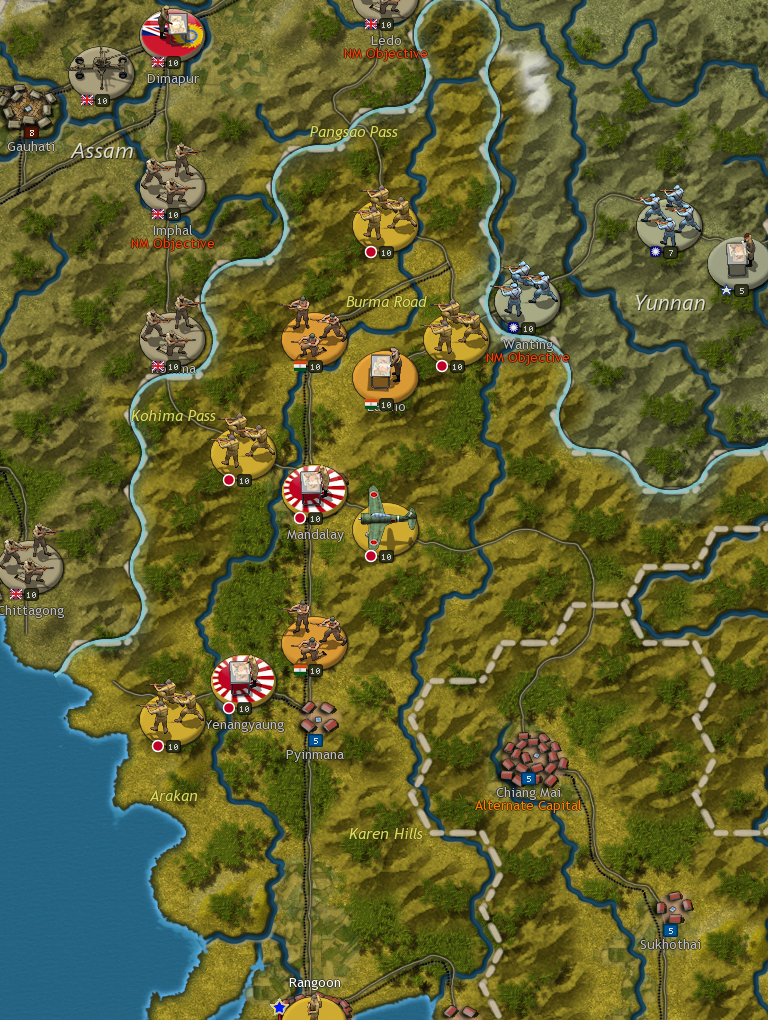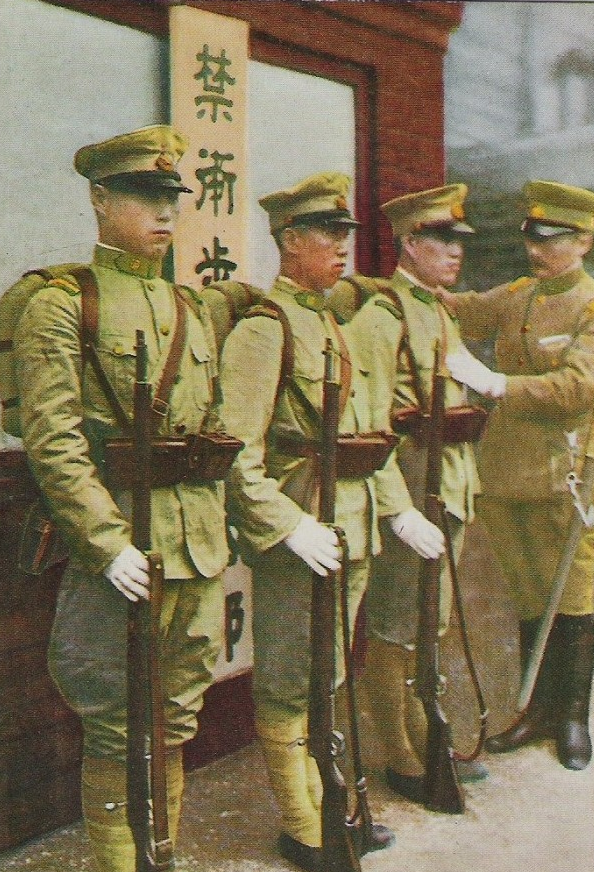Japan never fought alone in WWII, and to reflect this, units belonging to at least 8 separate entities can be deployed alongside Japanese forces to fight for the Axis.

The Indian Nationalist Subhas Chandra Bose giving a speech in Tokyo, 1943
Thailand
Thailand will join the Axis within a turn or two of the beginning of the Pacific War, deploying a Corps ready for service, with the potential to increase its forces further.
These will prove useful during the invasion of Burma and beyond, plus Thailand’s co-option into the Axis camp allows Japanese forces in the Gulf of Siam to concentrate on the conquest of Malaya and Singapore.
Free India
Following the capture of Singapore, Japan will be asked by the Indian Nationalist Mohan Singh for permission to raise an Indian National Army from among Indian deserters and Prisoners of War captured in Malaya.
This can be just the start of raising a sizeable Free Indian force, for should Japan invade India then it will be able to raise more Corps on seizing Bombay, Calcutta, Delhi and Dimapur. The 5 Corps that can potentially be raised will therefore prove a useful addition to Japan’s overall fighting strength, and they can even be given their own HQ in the shape of Subhas Chandra Bose.
"Give me blood, and I shall give you freedom!"
In 1943 the Indian Nationalist Subhas Chandra Bose will arrive in Japan from Europe, following his transfer from a German to Japanese submarine near Madagascar. Japan will then have the opportunity to deploy him as a HQ of the Indian National Army of Free India, enabling Bose to lead Indian forces into battle against the British!

Free Indian units including Subhas Chandra Bose fighting alongside Japanese forces in Burma
Japan can even gift some territory to the Indian National Army, for if it captures the Andaman and Nicobar Islands, then these islands can be handed over to Free India. Doing so will boost Japan’s National Morale as it will increase the credibility of Japan’s claims to be liberating Asia from Western Imperialism and founding a Greater East Asia Co-Prosperity Sphere in its place.
The State of Burma
With Burma and Malaya conquered, Japan’s successes will provide an impetus to supporters of Burmese Independence. These Burmese activists will already have helped Japan’s invasion by attacking British forces, and now they are willing to take up arms to fight alongside the Japanese. This unit could prove of use in in an invasion of India, or through supporting an advance into China and threatening Kunming.
China
Japan is greatly assisted in its war effort by all the dissension and divisions within Chinese society (see a future developer diary for details) and some Chinese factions have been recruited to fight alongside Japanese forces.
The most significant formation of Chinese to fight alongside Japan come under the nominal authority of Wang Jingwei’s collaborationist government based in Nanjing. However, Nanjing’s forces lack good leadership and are therefore best left in the rear to guard against partisan attacks.
Nevertheless, this lack of leadership can be rectified through capturing Taiyuan in Shanxi Province. For should they do so, Japan will have an opportunity to attempt to recruit the Shanxi Warlord Yan Xishan.
Negotiations were carried out during the war via Major-General Tanaka, a Japanese officer serving in China who was also a friend of his, and in 1942 Yan Xishan did tell the Japanese that he would be prepared to switch sides if he were provided with food, weapons and equipment with which to fight the Communists. Although he ultimately changed his mind and refused, Japan does have a significant chance of successfully convincing Yan Xishan to switch sides and deploy as a HQ in the service of Nanjing.
Additionally, there is Prince Demchugdongrub’s Mongolian Autonomous Federation, also known as Mengjiang, a small puppet state north west of Beiping that can deploy its own armed forces.
Demchugdongrub, also known as Prince de Wang, led a movement for Mongolian independence in the mid-1930s before collaborating with the Japanese, and in some circumstances his army can be expanded further in order to deploy cavalry for service in Mongolia or against the Soviet Union.
The Empire of Manchukuo
Manchukuo, Japan’s puppet state in Manchuria, has its own Emperor in the shape of Puyi, the former Emperor of China, and this minor empire also has its own armed forces.
These can be expanded later in the war as the threat of a Soviet invasion looms, with infantry and cavalry units being equipped and deployed ready to fight the Red Army. Will they be enough to make a difference when the decisive battle comes?

Some of the Emperor of Manchukuo’s soldiers
The Greater East Asia Conference
In November 1943 Japan can organise a Greater East Asia Conference of its allies, with attendees including Ba Maw (Burma), José P. Laurel and Sukarno (Philippines), Subhas Chandra Bose (India), and Wang Jinwei (China). There are both political and military benefits to Japan for organising this conference, for not only will its success boost Japanese National Morale, but it will also facilitate the recruitment of local volunteers in the Dutch East Indies, Malaya and the Philippines.
Laurel’s Philippines Republic will be prepared to raise a Makapili Militia that can assist with the defence of the country should MacArthur’s dream come true and he be able to return at the head of a US invasion force.
Militia units belonging to the Defenders of the Homeland (Pembela Tanah Air or PETA) can also be raised in the Dutch East Indies and Malaya. These are not strong units, but in the face of Allied invasions, every man may count!

PETA Militia undergoing training
Treachery and Desertion
Some of Japan’s allies are rather fickle, and if the war turns in favour of the Allies then they may switch sides or simply surrender. This could have disastrous strategic consequences, and therefore although these allies provide necessary reinforcements, some could also pose a threat.
While Thailand will be the first country to provide additional forces to fight alongside Japan’s in 1941 Day of Infamy, later in the war it could switch sides, deploying units to fight alongside the Allies. These units may not be strong, but they will at the bare minimum prove inconvenient to Japanese strategy, potentially facilitating a major Allied advance in South East Asia.
Of no less importance to Japan’s position in South East Asia is Indochina. Indochina has been under Japanese occupation since 1940, though its French authorities are neutral and are nominally still in power.
As the war progresses the French may develop plans to assist the Allies, timing their actions to take place at the same time as Allied forces advance into Indochina.
To prevent a French uprising, Japan can launch Operation Bright Moon to secure the country and disarm French forces. Casualties may be suffered in doing so, though it may be better than letting French forces rise and attack Japanese forces, especially as an Allied presence here would break Japan’s communications with Thailand and the frontline in Burma.
However, even having defeated French forces in Indochina, Japan’s problems may not end there as Ho Chi Minh’s Viet Minh can initiate Partisan activity in the north.
Overall, the many allied units that Japan can deploy to fight alongside her armed forces in 1941 Day of Infamy are a useful asset, providing us with a reminder that this was much more than a conflict fought between existing states. Axis players will therefore do well to mobilize these forces as much as possible in her favour, for one thing is certain: the Allies will be mobilizing massively for the battles ahead, and every single unit will have the potential to count in determining the winner of WWII: War in the Pacific!







